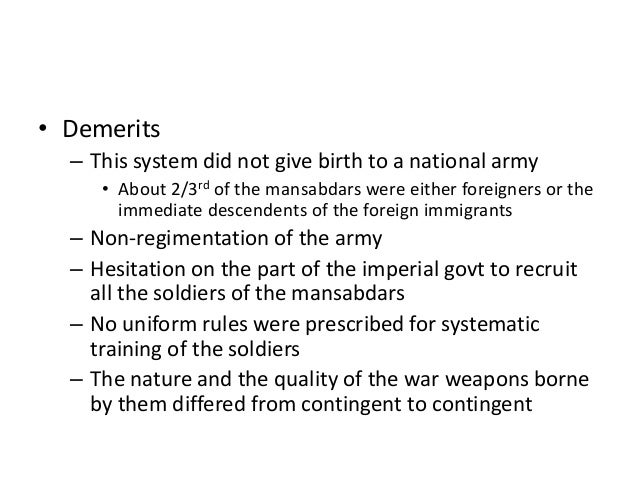Mughal
Jagirdari System
- The system of assignment of revenue of a particular territory to the nobles for their services to the state continued under the Mughals also. Under the Mughals, the areas assigned were generally called Jagir and its holders Jagirdars.

- The Jagirdari system was an integral part
of the mansabdari system which developed under Akbar and underwent
certain changes during the reign of his successors.
- During Akbar’s period all the territory was broadly divided into two: Khalisa and Jagir.

- The revenue from the first went to imperial treasury,
and that from Jagir was assigned to Jagirdars in lieu of their cash
salary.
- Salary entitlements of mansabdars were calculated on the basis of their Zat and Sawar ranks.

- The salary was paid either in cash (in that case they were called Naqdi) or through the assignment of a Jagir, the latter being the preferable mode.
- In case the payment was made through the assignment of a Jagir, the office of the central Diwan would identify parganas the sum total of whose Jama was equal to the salary claim of the mansabdars.
- In case the recorded Jama was in excess of salary claim
the assignee was required to deposit the balance with the central
treasury.
- On the other hand, if it was less than the salary claim the short fall was paid from the treasury. However, none of the assignments was permanent or hereditary.
- The Emperor could shift part or the entire Jagir
from one part of the imperial territory to another at any time.
- The ratio between Jagir and Khalisa kept
fluctuating during the Mughal rule.
- During Akbar’s period Khalisa was only 5% of total
revenue, under Jahangir it was 10%, under Shahjahan it fluctuated between
9 to 15%.

- In the latter part of Aurangzeb’s reign there was a
great pressure on the Khalisa as the number of claimants for Jagir
increased with the increase in the number of mansabdars.
- The jagirdars were also transferred from one Jagir to
another (but in certain cases they were allowed to keep their Jagir in one
locality for longer period of time).
- The system of transfer checked the
Jagirdars from developing local roots. At the same time, its disadvantage was that it
discouraged the Jagirdars from taking long term measures for the
development of their areas.
What were the types of JAGIRS ?
- There were various types of Jagirs.
1. Tankha Jagirs were
given in lieu of salaries,
2. Mashrut Jagirs were
given on certain conditions,
3. Watan Jagirs were
assigned to Zamindar or rajas in their local dominions.
4. Altamgha Jagirs were
given to Muslim nobles in their family towns or place of birth.
Tankha Jagirs were transferable every three to four years.
Watan Jagirs were hereditary and non transferable. When a Zamindar was made a
mansabdar, he was given Tankha Jagir apart from his watan. Jagir at another
place, if the salary of his rank was more than the income from his watan Jagir.
The Jagirdars were allowed to collect only authorized revenue in
accordance with the imperial regulations.
- The jagirdars
employed their own officials like 'AMIL' etc.
- The imperial office kept watch on the Jagirdars.
- The Diwan of the suba was supposed to prevent the
oppression of the peasants by the Jagirdars.
- Amin was posted in each suba to see that Jagirdars were
following imperial regulations.
- Faujdar used to help the Jagirdas if they faced any difficulty in the collection of revenue.




